Amphibians (phylum Chordata, subphylum Vertebrata, superclass Tetrapoda, class Amphibia) are vertebrates (animals with a backbone and a hollow tube of nervous tissue called a spinal cord) characterised by their limited physiological means to maintain the body temperature within a narrow range (or being ectothermic), the laying of gelatinous eggs, and two distinctive stages of life - the juveniles are mostly aquatic and breathe with gills, until they undergo metamorphosis to develop lungs and (usually) limbs, and eventually become air-breathing adults.
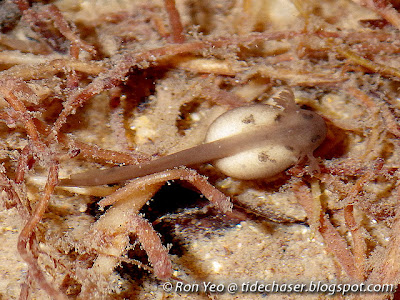
The above photo features a juvenile frog, otherwise commonly referred to as a tadpole, which has a tail but lacks limbs. Most amphibians can breathe through their skin as well, and in fact, some species are known to rely solely on their skin for air exchanges. Their skin is not waterproof, and hence they must remain moist to prevent dehydration. While the juveniles (usually called tadpoles) feed mostly on algae, plants and decaying organic matter, the adults are mostly carnivorous.
Amphibians are descended from four-limbed ancestors (hence the superclass Tetrepoda which means "four legs"). Hence, most amphibians, such as frogs and salamanders, have four limbs, though some salamanders have very reduced limbs, while the caecilians lack limbs altogether.
Salamanders are not recorded from Singapore, and I have not personally seen the very elusive caecilians yet. Hence, I can only share about some of the frogs that I have seen in Singapore here. Most of the information presented below are gotten from books and websites by Kelvin Lim and Nick Baker (thanks both!).
Family Rhacophoridae
Members of this family are commonly called tree frogs due to their arboreal habits. The tips of their digits are usually expanded into sticky pads, allowing them to climb up trees, bushes and other tall structures.

The Four-lined Tree Frog (Polypedates leucomystax) is frequently encountered in buildings in agricultural areas or near wooded areas, though they can also be found in secondary forests. It can grow to about 7.5cm long. The skin is relatively smooth, and the limbs are long and slender. The tips of the fingers and toes are expanded into sticky pads, allowing them to climb onto trees and the sides of buildings. The back is usually yellowish brown, brown or grey, with or without four dark lines. It is active at night, hunting mostly insects. The eggs are sometimes encountered stuck on low vegetation, in the form of a foam nest suspended over a water body. The nest breaks down during heavy rainfalls to release the tadpoles.

The Spotted Tree Frog (Nyctixalus pictus) is usually found on shrubs or trees. It can be easily identified by its orange to brown coloration marked with numerous small white spots. It is nocturnal and feeds mostly on insects. Interestingly, this frog lay its eggs in tree cavities. It can grow to about 3.5cm long.
Family Ranidae
Ranid frogs usually have slender bodies with long muscular back legs. The snout is pointed and the external ear drums (or tympanum) are usually very prominent. The tips of the fingers and toes of some species are expanded into disc-like structures.

The Common Greenback (Hylarana erythraea) is commonly encountered among floating and emergent water plants, or the vegetation at the edge of freshwater bodies in rural areas. It can grow to about 7.5cm, and is active at night, feeding on insects. The skin on the back is smooth and green or brownish on top, with two brown-edged white stripes by the sides. The upper lip is white in colour. The hind limbs are long and slender, and the tips of the digits are not expanded.

The Copper-cheeked Frog (Hydrophylax raniceps) is usually only found in the forest, often on low vegetation along the streams. It can grow to about 7cm long, and is mostly nocturnal, hunting insects. Interestingly, the back is usually green in the day, but may change to brownish at night. It has a white upper lip, and a dark brown mask over the sides of the head and ear drums. The hind legs are long and slender, and the tips of the fingers and toes are expanded and flattened into round pads.

The American Bullfrog (Lithobates catesbeiana) is an introduced species native to North America. Unfortunately, this species has been released into ponds and reservoirs for religious merit-making purposes. It feeds on small animals such as worms, insects, crustaceans and even other amphibians including their own kind. As such, they can be a major problem if they feed on our native frogs or out-compete our native animals since it is a fairly big frog (reaching about 15cm,). The back is usually greenish brown in colour, and the hind feet are well-webbed. In Singapore, they are bred in frog farms, as their hind legs are muscular with lots of meat for human consumption.
Family Bufonidae
Members of this family are usually called toads. They can be differentiated from other frogs by their generally warty and drier skin. There is usually a raised gland behind each eye.

The Asian Toad (Duttaphrynus melanostictus) is perhaps the most commonly seen amphibian in Singapore,. Growing to about 11cm long, it can be found in both urban and rural areas, and also in forests and coastal areas (even on islands!). It has a robust body and distinctly warty skin, greyish to yellowish brown in colour above. The hind legs are relatively short and slender, the fingers and toes have very reduced webbing. There is a raised, long oval-shaped gland along each side of the head, and on the top is a pair of dark low ridges. This toad is usually solitary, nocturnal and terrestrial, feeding mostly on insects. Its tadpoles have been observed to live in brackish water.

The Four-ridged Toad (Ingerophrynus quadriporcatus) is usually found in swampy areas in forests and at forest edges. It can grow to about 6cm long, and has a robust body with very warty, orange to brown skin. The hind limbs are relatively short and slender, and the feet have very reduced webbing. The raised gland along each side of the head is very slender, and on top of the head are four low ridges. It is terrestrial and feeds mostly on insects (probably at night). When disturbed, it has been observed to become very still and stiff to blend into the surrounding, and did not move even when touched.
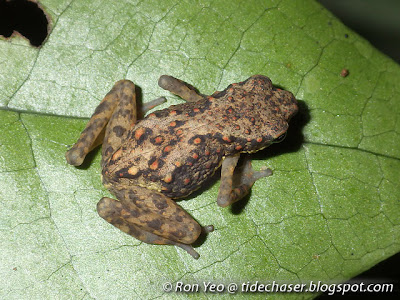
The Saint Andrew’s Cross Toadlet (Pelophryne signata) is so-named for the vague X-shaped pattern on its back. This toadlet grows to about 1.5cm long, and is usually found on small shrubs. It lays its eggs in tree cavities.
Family Dicroglossidae
Members of this family usually have robust bodies with muscular hind legs and large heads. They include some of the largest frogs in the region and some species have a pair of fangs on their jaws. They can be semi-aquatic or aquatic in habits.
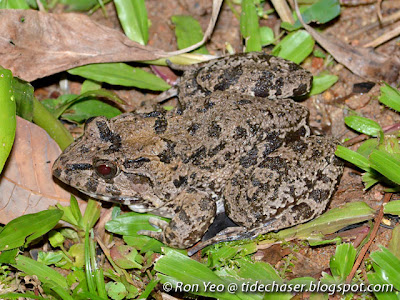
The Field Frog (Fejervarya limnocharis) can sometimes be seen in rural or suburban areas, or in fields, scrublands and forest clearings. It can grow to about 6cm long, greyish or brown above with irregular dark blotches. The skin on the back usually has short ridges. The head is longer than broad. It has long and muscular hind limbs with half-webbed feet. The adult males have a dark band on their throats. It is nocturnal and terrestrial, feeding mostly on insects. It can be easily confused with the next species.

The Crab-eating Frog (Fejervarya cancrivora) is easily confused with the previous species and it is also greyish to brown with dark blotches on its back, with long and muscular hind legs. However, the body is more robust and bigger (to more than 8cm long), the ridges on the back are usually longer, and the hind feet are extensively webbed. The throat of the adult male is white with a dark grey patch at the corners of the jaw. It can be found in a variety of habitats, ranging from suburban and rural areas to scrublands, secondary forest and even coastal forest and mangroves. The tadpoles can tolerate brackish water, and hence this species is even commonly seen on islands.
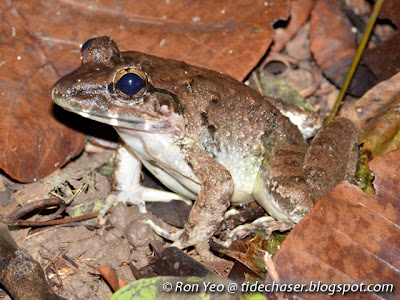
The Malayan Giant Frog (Limnonectes blythii) is the largest frog in Singapore, growing to more than 25cm long. It occurs along forest streams and in scrublands. It has a robust body with long and muscular hind limbs. The hind feet are extensively webbed. The head is large and slightly longer than wide. The skin on the back is brown or grey (may have a pale stripe in the middle) and relatively smooth in adults, but juveniles have warty skins. The throat is white. This nocturnal and semi-aquatic frog feeds on smaller animals. It is suspected that more than one species of very similar-looking frogs are classified under this scientific name. It can also be confused with the next species due to their resemblances.
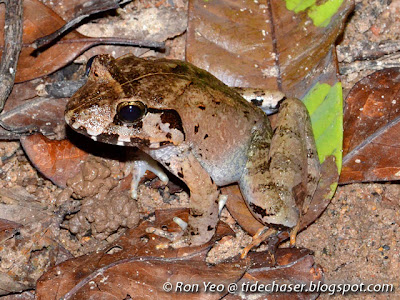
The Malesian Frog (Limnonectes malesianus) is sometimes mistaken for the previous species, as it also has a robust body, long and muscular hind legs, extensively webbed hind feet, and a large and broad head. It is usually smaller though, growing to about 15 cm long. The skin on the back is smooth and reddish brown in colour with several small dark speckles and, usually, a very thin place line in the middle and a W-shaped skin fold at the back of the "shoulder" area. It can also be differentiated with the previous species by the ear drum, which is half blackish. Above the ear drum is a skin fold forming a sharp angle. The throat is mottled dark grey with a white line down the middle. This nocturnal and semi-aquatic frog feeds on small animals, and is usually found in mature swampy forest.
Family Megophryidae
Members of this family are usually terrestrial frogs with relatively short and slender hind legs. Hence, they are only capable of making short leaps. Instead of leaping away to escape danger, they will usually hide among the leaf litter and surrounding low vegetation.

The Black-eyed Litter Frog (Leptobrachium nigrops) usually lives among the leaf litter on the forest floor, growing to about 5cm long. The limbs are short and slender, and the skin is grey or brown on the back and sides with irregular dark blotches. The underside is white and densely marked with dark speckles. It has prominent black eyes, giving it its common name. This solitary frog is usually active at night, feeding on insects.

The Malayan Horned Frog (Megophrys nasuta) has a pair of horn-like skin flaps above each eye and a sharply pointed snout. This frog is mostly terrestrial and nocturnal in habits. Its brownish coloration with dark brown blotches allows it to camouflage nicely into the surrounding leaf litter. It is thus able to effectively ambush its prey and also hide from predators. This large frog can reach a length of about 16cm, and is mostly found near shallow forest streams with clear water.
Family Microhylidae
Members of this family are commonly called narrow-mouthed frogs due to their relatively small heads and mouths. The ones in Singapore tend to burrow into the soil or hide in leaf litter.
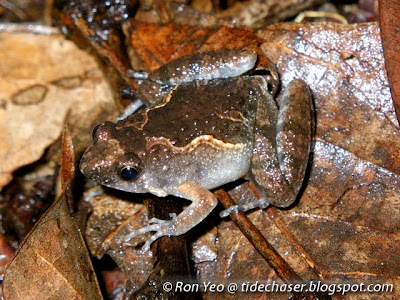
The Painted Chorus Frog (Microhyla butleri) is a small frog growing to about 2.5cm long. It can be found in suburban and rural habitats, scrublands, and secondary forests. It has a relatively small head compared to the body. The back is dark brown, with a wavy pale stripe on each side. The hind legs are long and slender with a few dark bands. This terrestrial species is active at night, feeding on insects.

The Dark-sided Chorus Frog (Microhyla heymonsi) is usually found in gardens, rural areas, scrubland and disturbed forests. This terrestrial frog is nocturnal, and lives near small puddles and ponds. It grows to about 2.5cm long, and can be recognised by the brownish back with a pale line in the middle and a dark band long the sides.
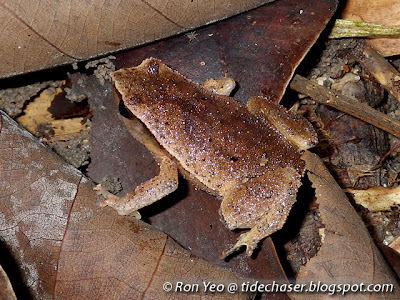
The Black-spotted Sticky Frog (Kalophrynus pleurostigma) is sometimes confused with the previous species due to its brownish coloration, but it lacks the pale line on its back. Also, it usually has numerous tiny black spots on its back, though some specimens may lack them. It also has an eye-like pattern in the groin area, though unfortunately I do not have photos of it. This largely nocturnal frog is usually found among the leaf litter on the floor of mature forests. The skin secretes a sticky substance, possibly to deter predators. It feeds mostly on small insects. This frog sometimes lays its eggs in tiny pools of water, such as the water trapped in tiny tree holes or cracks of fallen logs. It can reach lengths of about 5cm.

The Banded Bullfrog (Kaloula pulchra) is believed to be an introduced species, though it is very widely distributed in the region. Growing to about 7.5cm long, it has a rounded body and a relatively small head. The back legs are short and slender, and the tips of the fingers and toes are expanded and blunt. The back is grey or brown with a black-edged, pale yellow or orange band on each side. The front of the top of its head has the same colour. This frog is solitary and active at night, feeding mostly on ants. It can be found in gardens and fields in urban and rural areas, and also in the forests and on offshore islands. The call sounds like the call of cattle, and hence locally they are called "ground cattle" in various Chinese dialects. While it is mostly terrestrial, it is sometimes found on tree trunks as well.
References

The above photo features a juvenile frog, otherwise commonly referred to as a tadpole, which has a tail but lacks limbs. Most amphibians can breathe through their skin as well, and in fact, some species are known to rely solely on their skin for air exchanges. Their skin is not waterproof, and hence they must remain moist to prevent dehydration. While the juveniles (usually called tadpoles) feed mostly on algae, plants and decaying organic matter, the adults are mostly carnivorous.
Amphibians are descended from four-limbed ancestors (hence the superclass Tetrepoda which means "four legs"). Hence, most amphibians, such as frogs and salamanders, have four limbs, though some salamanders have very reduced limbs, while the caecilians lack limbs altogether.
Salamanders are not recorded from Singapore, and I have not personally seen the very elusive caecilians yet. Hence, I can only share about some of the frogs that I have seen in Singapore here. Most of the information presented below are gotten from books and websites by Kelvin Lim and Nick Baker (thanks both!).
Family Rhacophoridae
Members of this family are commonly called tree frogs due to their arboreal habits. The tips of their digits are usually expanded into sticky pads, allowing them to climb up trees, bushes and other tall structures.

The Four-lined Tree Frog (Polypedates leucomystax) is frequently encountered in buildings in agricultural areas or near wooded areas, though they can also be found in secondary forests. It can grow to about 7.5cm long. The skin is relatively smooth, and the limbs are long and slender. The tips of the fingers and toes are expanded into sticky pads, allowing them to climb onto trees and the sides of buildings. The back is usually yellowish brown, brown or grey, with or without four dark lines. It is active at night, hunting mostly insects. The eggs are sometimes encountered stuck on low vegetation, in the form of a foam nest suspended over a water body. The nest breaks down during heavy rainfalls to release the tadpoles.

The Spotted Tree Frog (Nyctixalus pictus) is usually found on shrubs or trees. It can be easily identified by its orange to brown coloration marked with numerous small white spots. It is nocturnal and feeds mostly on insects. Interestingly, this frog lay its eggs in tree cavities. It can grow to about 3.5cm long.
Family Ranidae
Ranid frogs usually have slender bodies with long muscular back legs. The snout is pointed and the external ear drums (or tympanum) are usually very prominent. The tips of the fingers and toes of some species are expanded into disc-like structures.

The Common Greenback (Hylarana erythraea) is commonly encountered among floating and emergent water plants, or the vegetation at the edge of freshwater bodies in rural areas. It can grow to about 7.5cm, and is active at night, feeding on insects. The skin on the back is smooth and green or brownish on top, with two brown-edged white stripes by the sides. The upper lip is white in colour. The hind limbs are long and slender, and the tips of the digits are not expanded.

The Copper-cheeked Frog (Hydrophylax raniceps) is usually only found in the forest, often on low vegetation along the streams. It can grow to about 7cm long, and is mostly nocturnal, hunting insects. Interestingly, the back is usually green in the day, but may change to brownish at night. It has a white upper lip, and a dark brown mask over the sides of the head and ear drums. The hind legs are long and slender, and the tips of the fingers and toes are expanded and flattened into round pads.

The American Bullfrog (Lithobates catesbeiana) is an introduced species native to North America. Unfortunately, this species has been released into ponds and reservoirs for religious merit-making purposes. It feeds on small animals such as worms, insects, crustaceans and even other amphibians including their own kind. As such, they can be a major problem if they feed on our native frogs or out-compete our native animals since it is a fairly big frog (reaching about 15cm,). The back is usually greenish brown in colour, and the hind feet are well-webbed. In Singapore, they are bred in frog farms, as their hind legs are muscular with lots of meat for human consumption.
Family Bufonidae
Members of this family are usually called toads. They can be differentiated from other frogs by their generally warty and drier skin. There is usually a raised gland behind each eye.

The Asian Toad (Duttaphrynus melanostictus) is perhaps the most commonly seen amphibian in Singapore,. Growing to about 11cm long, it can be found in both urban and rural areas, and also in forests and coastal areas (even on islands!). It has a robust body and distinctly warty skin, greyish to yellowish brown in colour above. The hind legs are relatively short and slender, the fingers and toes have very reduced webbing. There is a raised, long oval-shaped gland along each side of the head, and on the top is a pair of dark low ridges. This toad is usually solitary, nocturnal and terrestrial, feeding mostly on insects. Its tadpoles have been observed to live in brackish water.

The Four-ridged Toad (Ingerophrynus quadriporcatus) is usually found in swampy areas in forests and at forest edges. It can grow to about 6cm long, and has a robust body with very warty, orange to brown skin. The hind limbs are relatively short and slender, and the feet have very reduced webbing. The raised gland along each side of the head is very slender, and on top of the head are four low ridges. It is terrestrial and feeds mostly on insects (probably at night). When disturbed, it has been observed to become very still and stiff to blend into the surrounding, and did not move even when touched.

The Saint Andrew’s Cross Toadlet (Pelophryne signata) is so-named for the vague X-shaped pattern on its back. This toadlet grows to about 1.5cm long, and is usually found on small shrubs. It lays its eggs in tree cavities.
Family Dicroglossidae
Members of this family usually have robust bodies with muscular hind legs and large heads. They include some of the largest frogs in the region and some species have a pair of fangs on their jaws. They can be semi-aquatic or aquatic in habits.

The Field Frog (Fejervarya limnocharis) can sometimes be seen in rural or suburban areas, or in fields, scrublands and forest clearings. It can grow to about 6cm long, greyish or brown above with irregular dark blotches. The skin on the back usually has short ridges. The head is longer than broad. It has long and muscular hind limbs with half-webbed feet. The adult males have a dark band on their throats. It is nocturnal and terrestrial, feeding mostly on insects. It can be easily confused with the next species.

The Crab-eating Frog (Fejervarya cancrivora) is easily confused with the previous species and it is also greyish to brown with dark blotches on its back, with long and muscular hind legs. However, the body is more robust and bigger (to more than 8cm long), the ridges on the back are usually longer, and the hind feet are extensively webbed. The throat of the adult male is white with a dark grey patch at the corners of the jaw. It can be found in a variety of habitats, ranging from suburban and rural areas to scrublands, secondary forest and even coastal forest and mangroves. The tadpoles can tolerate brackish water, and hence this species is even commonly seen on islands.

The Malayan Giant Frog (Limnonectes blythii) is the largest frog in Singapore, growing to more than 25cm long. It occurs along forest streams and in scrublands. It has a robust body with long and muscular hind limbs. The hind feet are extensively webbed. The head is large and slightly longer than wide. The skin on the back is brown or grey (may have a pale stripe in the middle) and relatively smooth in adults, but juveniles have warty skins. The throat is white. This nocturnal and semi-aquatic frog feeds on smaller animals. It is suspected that more than one species of very similar-looking frogs are classified under this scientific name. It can also be confused with the next species due to their resemblances.

The Malesian Frog (Limnonectes malesianus) is sometimes mistaken for the previous species, as it also has a robust body, long and muscular hind legs, extensively webbed hind feet, and a large and broad head. It is usually smaller though, growing to about 15 cm long. The skin on the back is smooth and reddish brown in colour with several small dark speckles and, usually, a very thin place line in the middle and a W-shaped skin fold at the back of the "shoulder" area. It can also be differentiated with the previous species by the ear drum, which is half blackish. Above the ear drum is a skin fold forming a sharp angle. The throat is mottled dark grey with a white line down the middle. This nocturnal and semi-aquatic frog feeds on small animals, and is usually found in mature swampy forest.
Family Megophryidae
Members of this family are usually terrestrial frogs with relatively short and slender hind legs. Hence, they are only capable of making short leaps. Instead of leaping away to escape danger, they will usually hide among the leaf litter and surrounding low vegetation.

The Black-eyed Litter Frog (Leptobrachium nigrops) usually lives among the leaf litter on the forest floor, growing to about 5cm long. The limbs are short and slender, and the skin is grey or brown on the back and sides with irregular dark blotches. The underside is white and densely marked with dark speckles. It has prominent black eyes, giving it its common name. This solitary frog is usually active at night, feeding on insects.

The Malayan Horned Frog (Megophrys nasuta) has a pair of horn-like skin flaps above each eye and a sharply pointed snout. This frog is mostly terrestrial and nocturnal in habits. Its brownish coloration with dark brown blotches allows it to camouflage nicely into the surrounding leaf litter. It is thus able to effectively ambush its prey and also hide from predators. This large frog can reach a length of about 16cm, and is mostly found near shallow forest streams with clear water.
Family Microhylidae
Members of this family are commonly called narrow-mouthed frogs due to their relatively small heads and mouths. The ones in Singapore tend to burrow into the soil or hide in leaf litter.

The Painted Chorus Frog (Microhyla butleri) is a small frog growing to about 2.5cm long. It can be found in suburban and rural habitats, scrublands, and secondary forests. It has a relatively small head compared to the body. The back is dark brown, with a wavy pale stripe on each side. The hind legs are long and slender with a few dark bands. This terrestrial species is active at night, feeding on insects.

The Dark-sided Chorus Frog (Microhyla heymonsi) is usually found in gardens, rural areas, scrubland and disturbed forests. This terrestrial frog is nocturnal, and lives near small puddles and ponds. It grows to about 2.5cm long, and can be recognised by the brownish back with a pale line in the middle and a dark band long the sides.

The Black-spotted Sticky Frog (Kalophrynus pleurostigma) is sometimes confused with the previous species due to its brownish coloration, but it lacks the pale line on its back. Also, it usually has numerous tiny black spots on its back, though some specimens may lack them. It also has an eye-like pattern in the groin area, though unfortunately I do not have photos of it. This largely nocturnal frog is usually found among the leaf litter on the floor of mature forests. The skin secretes a sticky substance, possibly to deter predators. It feeds mostly on small insects. This frog sometimes lays its eggs in tiny pools of water, such as the water trapped in tiny tree holes or cracks of fallen logs. It can reach lengths of about 5cm.

The Banded Bullfrog (Kaloula pulchra) is believed to be an introduced species, though it is very widely distributed in the region. Growing to about 7.5cm long, it has a rounded body and a relatively small head. The back legs are short and slender, and the tips of the fingers and toes are expanded and blunt. The back is grey or brown with a black-edged, pale yellow or orange band on each side. The front of the top of its head has the same colour. This frog is solitary and active at night, feeding mostly on ants. It can be found in gardens and fields in urban and rural areas, and also in the forests and on offshore islands. The call sounds like the call of cattle, and hence locally they are called "ground cattle" in various Chinese dialects. While it is mostly terrestrial, it is sometimes found on tree trunks as well.
References
- Baker, N. 2013. Ecology Asia. Retrieved Feb 12, 2013, from http://www.ecologyasia.com.
- Baker, N. & K. Lim, (Vertebrate Study Group, Nature Society Singapore). 2008. Wild Animals Of Singapore. Draco Publishing and Distribution Pte. Ltd. 180 pp.
- Leong, T. M. & S. C Teo. 2009 Endotrophic tadpoles of the Saint Andrew’s Cross Toadlet, Pelophryne signata (Amphibia: Anura: Bufonidae) in Singapore. Nature in Singapore, 2: 21-25.
- Lim, K.P. & L. K. Lim. 1992. A Guide to the Amphibians & Reptiles of Singapore. Singapore Science Centre. 160 pp.

No comments:
Post a Comment